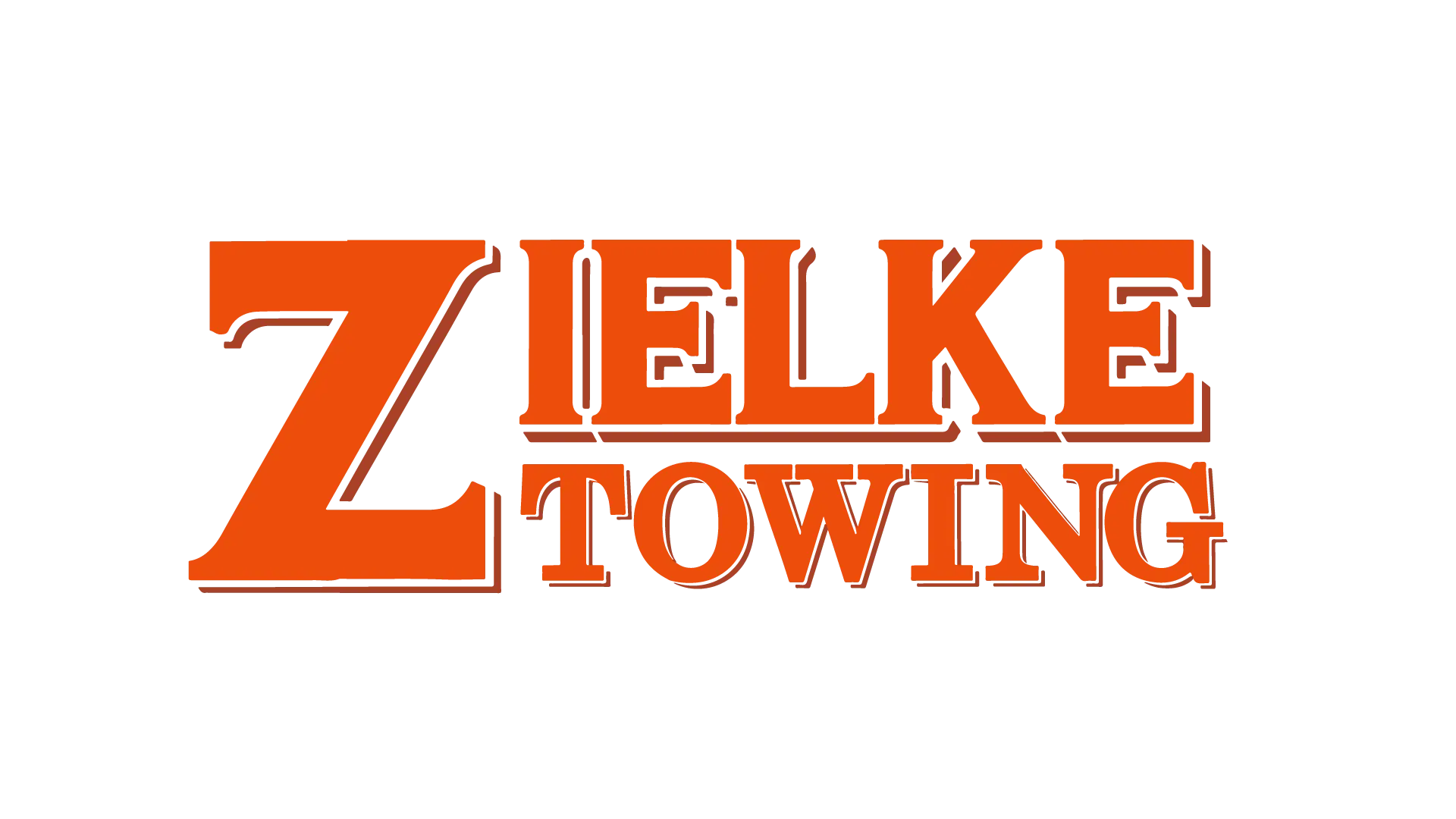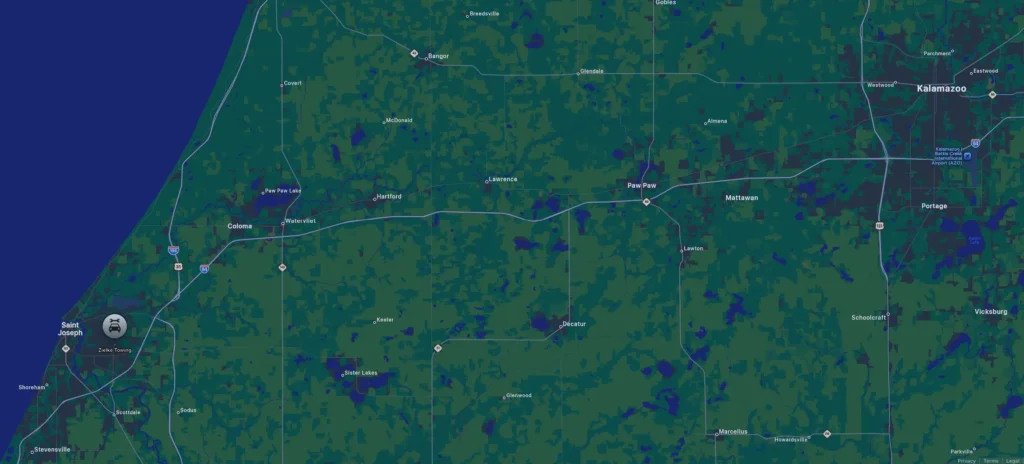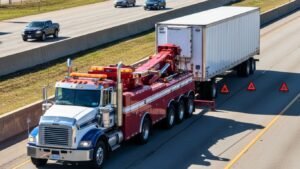The Hidden Cost Center Every Fleet Manager Faces
Unexpected truck breakdowns don’t just stop operations – they devastate fleet budgets. Every fleet manager knows that sinking feeling when a driver calls about a breakdown on a critical delivery route. What starts as a mechanical failure quickly snowballs into a cascade of expenses that can derail quarterly budgets and operational efficiency.
The problem isn’t just the breakdown itself. It’s the towing costs spiraling out of control without a proper strategy. Industry reports show that fleet managers underestimate their true towing expenses by 35-50%, failing to account for hidden indirect costs that multiply the financial impact of each incident.
This comprehensive guide provides a data-driven approach to minimize towing expenses and maximize fleet uptime. You’ll discover proven frameworks that leading fleet operators use to transform towing from an uncontrolled expense into a manageable operational component. Drawing from industry benchmarks and fleet management best practices, this analysis gives you the tools to control costs now and optimize your fleet efficiency for sustainable growth.
Understanding Fleet Towing Cost Components
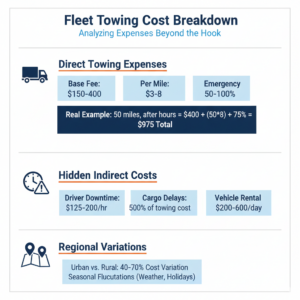
Direct Towing Expenses Breakdown
Fleet towing economics start with understanding the direct costs that hit your budget immediately. Heavy-duty flatbed rates typically range from $150-400 per incident, depending on vehicle weight class and local market conditions. These base rates represent only the foundation of your towing investment.
Mileage charges add substantial costs, particularly for long-distance recoveries. Industry averages suggest $3-8 per mile beyond the initial service radius, which varies by provider and region. Emergency vs. scheduled towing premiums can increase costs by 50-100%, making breakdown timing a critical factor in your total expense calculation.
Consider the real-world scenario: A Class 8 truck breakdown 75 miles from the nearest service center during peak hours. Direct costs: $350 base rate + $450 mileage charges + $175 emergency premium = $975 for a single incident.
Hidden Indirect Costs
The true economics of fleet towing economics extend far beyond the tow truck bill. Driver downtime and labor costs compound rapidly, especially when drivers must wait with disabled vehicles or arrange alternative transportation. Fleet managers report that driver-related costs average $125-200 per incident, depending on hourly rates and overtime implications.
Cargo delays and customer penalties create the most significant hidden expense. Late delivery fees, customer relationship damage, and expedited shipping costs to meet commitments can exceed the original towing expense by 300-500%. These truck breakdown expenses often don’t appear in transportation budgets, masking the true cost impact.
Replacement vehicle rental expenses add another layer of complexity. Daily rental rates for comparable commercial vehicles range from $200-600, with multi-day breakdowns creating substantial additional costs. Calculate these expenses over your average repair timeline to understand the full financial impact.
Regional Cost Variations
Geographic location dramatically affects your fleet towing economics. Urban vs. rural towing availability creates significant cost disparities, with metropolitan areas offering competitive rates but rural regions commanding premium prices due to limited provider networks.
Local market rate differences can vary by 40-70% between regions, making standardized budgeting challenging for multi-regional fleets. Seasonal demand fluctuations in areas with extreme weather conditions can double standard rates during peak breakdown periods.
What’s your current cost per towing incident when accounting for all these factors? Most fleet managers discover their true costs exceed budget estimates by 200-400%.
Heavy-Duty Towing: When Your Investment Needs Protection

Commercial Fleet Towing Requirements
Heavy-duty commercial towing operates under different parameters than standard vehicle recovery. Weight class considerations for Class 6-8 trucks require specialized equipment and certified operators, directly impacting service costs and availability.
Specialized equipment for heavy vehicles includes rotator trucks, heavy-duty flatbeds, and rigging systems that cost providers $300,000-800,000 per unit. This investment requirement limits the number of qualified providers and increases service costs, but ensures proper handling of valuable fleet assets.
DOT compliance during towing operations adds regulatory complexity and cost. Proper permits, escort vehicles for oversized loads, and compliance documentation require additional time and resources that providers pass through to fleet customers.
Cost-Benefit Analysis of Premium Towing
The decision framework for premium towing services follows a clear cost-benefit structure: Higher upfront costs vs. asset protection creates a compelling ROI calculation when evaluated properly.
Insurance claim prevention value becomes evident when comparing premium towing costs against potential damage claims. A $200 upgrade to premium service can prevent thousands in damage claims, making the investment decision straightforward.
Brand reputation preservation carries quantifiable value for fleets serving high-visibility customers. Professional towing that minimizes public exposure and maintains schedule reliability supports customer retention and premium pricing strategies.
Contract Towing vs. On-Demand Services
Annual Contract Benefits
Strategic towing partnerships offer predictable budgeting advantages that transform variable expenses into manageable operational costs. Annual contracts typically provide 15-25% cost savings compared to on-demand pricing, while delivering enhanced service reliability.
Priority response guarantees ensure your fleet receives preferential treatment during high-demand periods. Contract customers report average response times 40-60% faster than on-demand users, reducing total incident costs through shorter downtime periods.
Volume discount negotiations become possible with consistent service relationships. Fleet managers securing annual contracts often achieve additional 10-20% savings through volume commitments and relationship-based pricing.
Pay-Per-Use Flexibility
Cash flow management benefits make on-demand services attractive for smaller fleets or operations with unpredictable breakdown patterns. This approach distributes costs across actual incidents rather than requiring upfront commitments.
Risk distribution across incidents allows fleet managers to optimize spending based on actual needs rather than projected volumes. Market rate optimization opportunities exist for fleets with strong vendor management capabilities and multiple provider relationships.
Hybrid Approach Strategies
The most effective fleet towing strategies combine contract and on-demand elements. Core route coverage contracts provide cost-effective baseline services for primary operational areas, while emergency backup service agreements cover unusual circumstances and extended geographic requirements.
This hybrid model typically reduces overall towing costs by 20-35% while maintaining operational flexibility for changing business requirements.
Fleet-Specific Cost Optimization Strategies
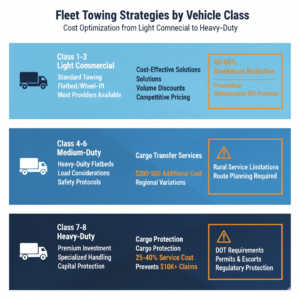
Light Commercial Vehicles (Class 1-3)
Standard towing solutions for lighter commercial vehicles offer the most cost-effective options in fleet towing economics. These vehicles typically require basic flatbed or wheel-lift services available from most providers, creating competitive pricing opportunities.
Cost-effective service networks for light commercial operations leverage broader provider availability and standardized equipment. Fleet managers can negotiate favorable rates through volume agreements while maintaining service quality standards.
Preventive maintenance ROI becomes particularly attractive for light commercial fleets, where proactive maintenance programs can reduce breakdown frequency by 45-65%. Calculate your annual towing budget using this framework: (Current annual incidents × average cost per incident) – (preventive maintenance investment) = potential savings.
Medium-Duty Trucks (Class 4-6)
Specialized equipment requirements for medium-duty trucks create a middle ground in commercial towing services. These vehicles often require heavy-duty flatbeds but don’t demand the most expensive equipment, providing cost optimization opportunities.
Load considerations and safety become critical factors affecting both service requirements and costs. Loaded medium-duty trucks may require cargo transfer services, adding $200-500 to incident costs but protecting valuable freight and vehicle systems.
Regional service availability for medium-duty towing varies significantly, with rural areas often lacking appropriate equipment. Factor these geographic limitations into your route planning and vendor selection strategies.
Heavy-Duty Operations (Class 7-8)
Premium towing investment justification for Class 7-8 operations follows clear economic logic. These vehicles represent significant capital investments requiring specialized handling to prevent costly damage during recovery operations.
Cargo protection protocols for heavy-duty towing can add 25-40% to service costs but prevent cargo claims that typically exceed $10,000 per incident. The investment in proper towing procedures pays for itself through claim prevention and cargo integrity maintenance.
Regulatory compliance costs for heavy-duty towing include permits, escorts, and documentation that add complexity but ensure legal operation. These requirements, while costly, protect against regulatory violations that can result in significant fines and operational restrictions.
Technology and Fleet Towing Economics
GPS Tracking and Dispatch Optimization
Modern fleet management technology transforms towing economics through intelligent dispatch and provider selection. Nearest provider identification reduces mileage charges by 20-30% while improving response times and minimizing driver downtime.
Response time improvements through GPS tracking and automated dispatch can cut total incident costs by 15-25%. Every minute saved in response time translates directly to reduced driver wages, faster cargo delivery, and improved customer satisfaction.
Cost per mile reductions become possible when technology identifies the most efficient recovery routes and provider locations. Fleet managers using advanced dispatch systems report 12-18% lower average towing costs through optimized routing and provider selection.
Predictive Maintenance Impact
The relationship between maintenance quality and towing frequency creates the strongest ROI opportunity in fleet towing economics. Breakdown prevention strategies using predictive maintenance can reduce towing incidents by 40-70%, dramatically improving budget predictability.
Scheduled maintenance vs. emergency repairs creates a cost multiplier effect. Industry data shows that preventive maintenance costs 60-80% less than emergency repairs, while virtually eliminating associated towing expenses.
Data-driven decision making enables fleet managers to identify breakdown patterns and target maintenance investments for maximum towing cost reduction. Track your fleet’s breakdown frequency against maintenance schedules to identify optimization opportunities.
Digital Fleet Management Integration
Automated incident reporting streamlines the towing process while capturing data for continuous improvement. Real-time cost tracking provides immediate visibility into towing expenses, enabling rapid response to budget overruns.
Performance analytics and KPIs transform towing from a reactive expense to a managed operational component. Monitor these key metrics: average cost per incident, response times by provider, breakdown frequency by vehicle, and total cost trends over time.
Risk Management and Insurance Considerations
Liability Coverage Analysis
Understanding coverage gaps between fleet insurance vs. towing company coverage prevents costly surprises during claims processing. Gap analysis and risk exposure evaluation should be conducted annually to ensure adequate protection levels.
Premium impact calculations help optimize insurance strategies by balancing deductibles, coverage limits, and risk tolerance. Higher towing coverage may reduce overall insurance costs by demonstrating proactive risk management to underwriters.
Self-Insurance vs. Third-Party Coverage
Break-even analysis frameworks help determine optimal insurance strategies for towing-related expenses. Large fleets often benefit from self-insurance approaches that retain control over costs and claims processing.
Reserve fund management for self-insured towing expenses requires careful cash flow planning and risk assessment. Claims frequency modeling based on historical data provides the foundation for reserve calculations and budget planning.
Documentation and Compliance Costs
Incident reporting requirements, regulatory filing expenses, and legal protection investments add administrative costs to towing operations. Proper documentation prevents disputes and supports insurance claims, justifying the administrative investment.
Regional and Seasonal Cost Management
Geographic Cost Variations
Metropolitan area premium rates reflect higher operational costs but provide better service availability and competition. Rural service availability challenges often result in limited provider options and higher costs, requiring strategic planning for routes through underserved areas.
Cross-border towing complications add regulatory complexity and cost for fleets operating across state or national boundaries. Factor these additional requirements into route planning and vendor selection decisions.
Seasonal Demand Planning
Winter weather preparation costs include enhanced service agreements and emergency response capabilities that prevent catastrophic service failures during peak breakdown periods. Holiday surcharge management requires advance planning and contract negotiations to control costs during high-demand periods.
Peak season capacity planning ensures service availability when breakdowns increase due to weather conditions, increased freight volumes, and extended operating hours.
Local Partnership Development
Regional provider relationships create competitive advantages through priority service, volume pricing, and enhanced reliability. Community-based service networks provide backup coverage and local market knowledge that improves service quality and cost management.
Emergency response coordination with local partners ensures rapid response capabilities even in remote operational areas.
Building Your Fleet Towing Strategy
Cost Analysis Framework
Total cost of ownership calculations must include all direct and indirect expenses associated with towing incidents. ROI measurement methodologies should evaluate the full cost impact of service decisions rather than focusing solely on immediate expenses.
Budget forecasting models based on historical data and operational projections provide the foundation for strategic planning and vendor negotiations. Use this framework: Base incidents × average cost + growth factor + inflation adjustment = annual budget requirement.
Vendor Selection Criteria
Service level agreements should specify response times, equipment standards, coverage areas, and performance penalties to ensure accountability. Response time guarantees become critical for operations where downtime costs exceed towing expenses.
Equipment quality standards ensure providers maintain appropriate equipment for your fleet requirements while preventing damage from inadequate recovery procedures.
Performance Monitoring Systems
Key performance indicators for towing services should include average response time, cost per incident, service quality ratings, and provider reliability metrics. Cost tracking mechanisms provide real-time visibility into spending patterns and trend analysis.
Continuous improvement processes use performance data to optimize provider relationships, negotiate better terms, and identify operational improvements that reduce breakdown frequency.
Conclusion & Strategic Recommendations
Final Answer: How to Control Fleet Towing Economics
The answer to controlling fleet towing costs lies in strategic planning and proactive management. Industry analysis shows that strategic planning reduces costs by 25-40% compared to reactive approaches, while proactive management prevents budget surprises that can derail operational efficiency.
Successful cost control requires treating towing as a strategic operational component rather than an unavoidable expense. Fleet managers who implement comprehensive towing strategies achieve predictable budgets, improved service reliability, and enhanced operational efficiency.
Building a Sustainable Fleet Operation
Develop comprehensive towing partnerships that provide consistent service, competitive pricing, and operational support aligned with your business requirements. Implement predictive maintenance programs that reduce breakdown frequency while improving vehicle reliability and total cost management.
Create data-driven decision frameworks that evaluate towing decisions based on total cost impact rather than immediate expenses. This approach transforms fleet towing economics from a cost center into a managed operational advantage that supports business growth and profitability.
The economics of truck towing for fleet managers demands strategic thinking, data-driven analysis, and proactive management. Control costs now through comprehensive planning, optimize your fleet efficiency through strategic partnerships, and build sustainable operations that support long-term success.
